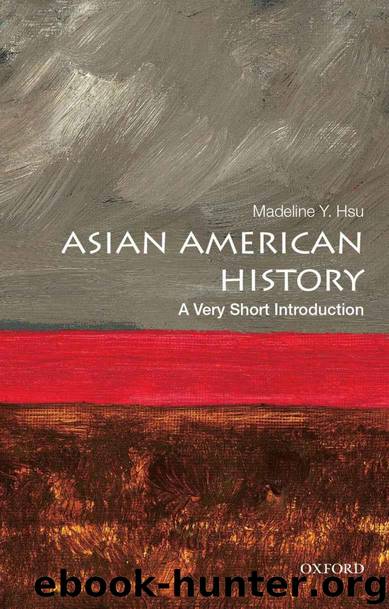Asian American History: A Very Short Introduction (Very Short Introductions) by Hsu Madeline Y

Author:Hsu, Madeline Y. [Hsu, Madeline Y.]
Language: eng
Format: azw3
ISBN: 9780190219789
Publisher: Oxford University Press
Published: 2016-10-31T16:00:00+00:00
The depths of exclusion
Japanese Americans faced high levels of antagonism, despite and partially due to their very successes in demonstrating their capacities to attain key markers of good citizenship such as establishing multigenerational small family farms, organizing and dominating particular sectors of agricultural markets and distribution chains, and the compliance with American cultural norms, including high educational attainment and socialization of Nisei. Nonetheless, fears that Japanese would overrun agriculture in California and Washington state, both in establishing agricultural toeholds but also through children born with US citizenship, contributed to widely supported passage of the Alien Land Laws and pressures on the Japanese government to end the picture-bride practice in 1920. Over the objections of Japanese Americans, the Japanese government chose to mitigate tensions with the US government by cooperating.
World War II brought about the worst that Japanese Americans could have anticipated by sweeping away the communities they had created and claimed with such diligence and stubbornness on the West Coast. The rationale of “military necessity” targeted the essentialized foreignness of Japanese, even American-born citizens, in justifying their removal into “relocation camps” as “enemy aliens” identified by ancestry rather than place of birth and citizenship. This nadir of civil rights violations would, however, give rise to the conditional possibility for the integration of Asians into America.
For example, the Okubos, like many other Japanese American families, had eked out impressive levels of attainment despite sharply constricted circumstances. Mine Okubo (1912–2001) was one of seven children growing up in Riverside, California. Her mother was a calligrapher and her father a scholar who had arrived to study in 1904 and chose to stay in the United States. He could only find work in a candy factory and as a gardener while her mother raised the children. Nonetheless, Okubo managed to attend high school and Riverside Community College before transferring to the University of California at Berkeley, where she received her bachelor’s and master’s degrees and gained some prominence as an artist. When World War II broke out, Okubo was in Europe on a Bertha Taussig Memorial Traveling Fellowship. She returned to the United States and found a job with the Works Progress Administration in San Francisco, demonstrating the fresco technique of mural-making alongside the Mexican artist Diego Rivera.
In the early morning hours of December 7, 1941, Japanese planes struck Pearl Harbor and President Franklin D. Roosevelt signed Executive Order 9066 on February 19, 1942, authorizing the evacuation of Japanese and Japanese Americans on the West Coast. Issei leaders were swiftly rounded up, an 8 p.m. curfew was imposed, and bank accounts were frozen. Once it became clear that even citizen Nisei would be rounded up, about ten thousand Japanese moved voluntarily inland, outside the military zone, to avoid incarceration. The newlywed Kanemoto Hatsu and her husband moved from San Jose County to Colorado, where they found low-paying employment as farm laborers. Hatsu later deeply mourned their loss of autonomy and downgrade into a “hand-to-mouth” existence, as her family slid steadily into debt as sharecroppers farming onions and cabbages.
Download
This site does not store any files on its server. We only index and link to content provided by other sites. Please contact the content providers to delete copyright contents if any and email us, we'll remove relevant links or contents immediately.
| African-American Studies | Asian American Studies |
| Disabled | Ethnic Studies |
| Hispanic American Studies | LGBT |
| Minority Studies | Native American Studies |
Cecilia; Or, Memoirs of an Heiress — Volume 1 by Fanny Burney(32498)
Cecilia; Or, Memoirs of an Heiress — Volume 2 by Fanny Burney(31911)
Cecilia; Or, Memoirs of an Heiress — Volume 3 by Fanny Burney(31895)
The Great Music City by Andrea Baker(31759)
We're Going to Need More Wine by Gabrielle Union(19004)
All the Missing Girls by Megan Miranda(15781)
Pimp by Iceberg Slim(14437)
Bombshells: Glamour Girls of a Lifetime by Sullivan Steve(14024)
For the Love of Europe by Rick Steves(13616)
Talking to Strangers by Malcolm Gladwell(13293)
Norse Mythology by Gaiman Neil(13281)
Fifty Shades Freed by E L James(13188)
Mindhunter: Inside the FBI's Elite Serial Crime Unit by John E. Douglas & Mark Olshaker(9265)
Crazy Rich Asians by Kevin Kwan(9224)
The Lost Art of Listening by Michael P. Nichols(7455)
Enlightenment Now: The Case for Reason, Science, Humanism, and Progress by Steven Pinker(7274)
The Four Agreements by Don Miguel Ruiz(6703)
Bad Blood by John Carreyrou(6584)
Weapons of Math Destruction by Cathy O'Neil(6220)
